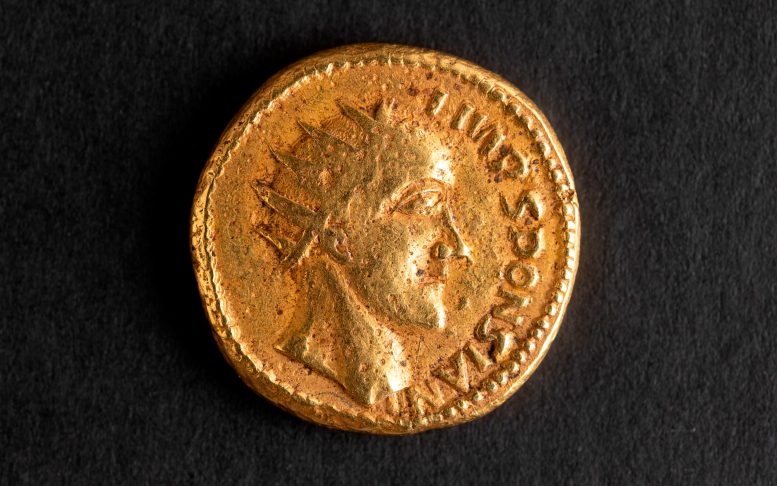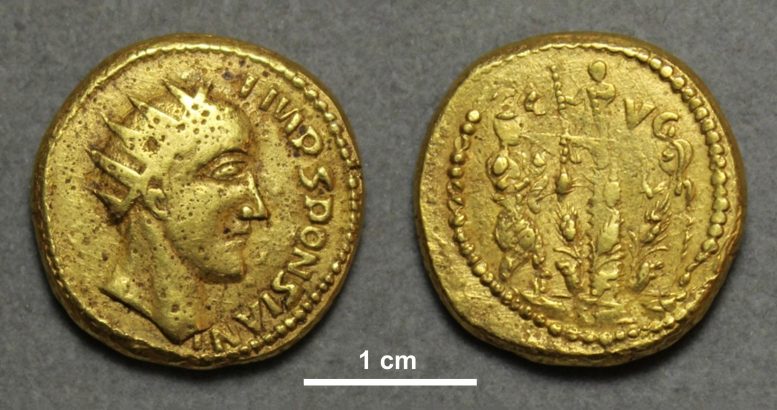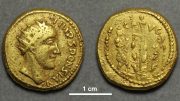
Sponsian gold coin, c.260-c.270 CE (obverse). Credit: The Hunterian, University of Glasgow
According to recent University College of London research, a gold coin long regarded as a fake appears to be authentic and portrays a long-lost Roman emperor named Sponsian.
A recent study conducted by the University College London (UCL) suggests that a gold coin long thought to be a forgery depicting a long-lost Roman emperor by the name of Sponsian is really authentic.
The coin was discovered in Transylvania, in modern-day Romania, in 1713 and is now kept in The Hunterian collection at the University of Glasgow. A few other coins of the same design were also discovered there. Because of their crude, strange design features and jumbled inscriptions, they have been believed to be fake since the mid-19th century.
In the new study, published in PLOS ONE, researchers compared the Sponsion coin with other Roman coins kept at The Hunterian, including two that are known to be genuine.

Coin of the ‘emperor’ Sponsian, currently in The Hunterian, University of Glasgow, UK, catalog number GLAHM:40333 (reproduced from Ref. [1]). Credit: Pearson et al., 2022, PLOS ONE, CC-BY 4.0
Lead author Professor Paul N. Pearson (UCL Earth Sciences) said: “Scientific analysis of these ultra-rare coins rescues the emperor Sponsian from obscurity. Our evidence suggests he ruled Roman Dacia, an isolated gold mining outpost, at a time when the empire was beset by civil wars and the borderlands were overrun by plundering invaders.”
The Roman province of Dacia, a territory overlapping with modern-day Romania, was a region prized for its gold mines. Archaeological studies have established that the area was cut off from the rest of the Roman empire in around 260 CE. Surrounded by enemies, Sponsian may have been a local army officer forced to assume supreme command during a period of chaos and civil war, protecting the military and civilian population of Dacia until order was restored, and the province evacuated between 271 and 275 CE.
Coinage has always been an important symbol of power and authority. Recognizing this and unable to receive official issues from the mint in Rome, Sponsian seems to have authorized the creation of locally produced coins, some featuring an image of his face, to support a functioning economy in his isolated frontier territory.
When the coins were discovered in the early 18th century, they were thought to be genuine and classed alongside other imitations of Roman coins made beyond the fringes of the empire. However, from the mid-19th century, attitudes changed. Coins from the hoard were dismissed as fakes because of the way they looked. This has been the accepted view until now.
The new study is the first time scientific analysis has been undertaken on any of the Sponsian coins. The research team used powerful microscopes in visible and ultraviolet light, as well as scanning electron microscopy and spectroscopy – studying how light at different wavelengths is absorbed or reflected – to study the coins’ surface.
Only four coins featuring Sponsian are known to have survived to the present day, all apparently originally from the 1713 hoard. Another is in Brukenthal National Museum in Sibiu, Romania. High magnification microscopic analysis performed there, following the research on the coin at The Hunterian, has revealed similar evidence of authenticity.
Curator of Numismatics at The Hunterian, Jesper Ericsson, said: “This has been a really exciting project for The Hunterian and we’re delighted that our findings have inspired collaborative research with museum colleagues in Romania. Not only do we hope that this encourages further debate about Sponsian as a historical figure, but also the investigation of coins relating to him held in other museums across Europe.”
The interim manager of the Brukenthal National Museum, Alexandru Constantin Chituță, said: “For the history of Transylvania and Romania in particular, but also for the history of Europe in general if these results are accepted by the scientific community they will mean the addition of another important historical figure in our history.”
He concludes, “It is a wonderful thing for the Brukenthal National Museum, because the museum in Sibiu, Romania, is the holder of the only known coin belonging to Sponsian from the territory of Romania. I would like to express my gratitude to my colleagues from the Brukenthal Național Museum – History Museum Altemberger House and especially to the leader of the scientific team, Professor Paul N. Pearson from UCL, for their commitment, hard work, and their impressive result.”
Four gold coins analysed by researchers, including the Sponsian coin and other Roman coins previously dismissed as forgeries, are on display in The Hunterian at the University of Glasgow, while the Sponsian coin in the Brukenthal National Museum is also on public display.
Reference: “Authenticating coins of the ‘Roman emperor’ Sponsian” by Paul N. Pearson, Michela Botticelli, Jesper Ericsson, Jacek Olender and Liene Spruženiece, 23 November 2022, PLOS ONE.
DOI: 10.1371/journal.pone.0274285








Be the first to comment on "Thought To Be Fake for Over 150 Years: Ancient Roman Coins Reveal a Long-Lost Emperor"